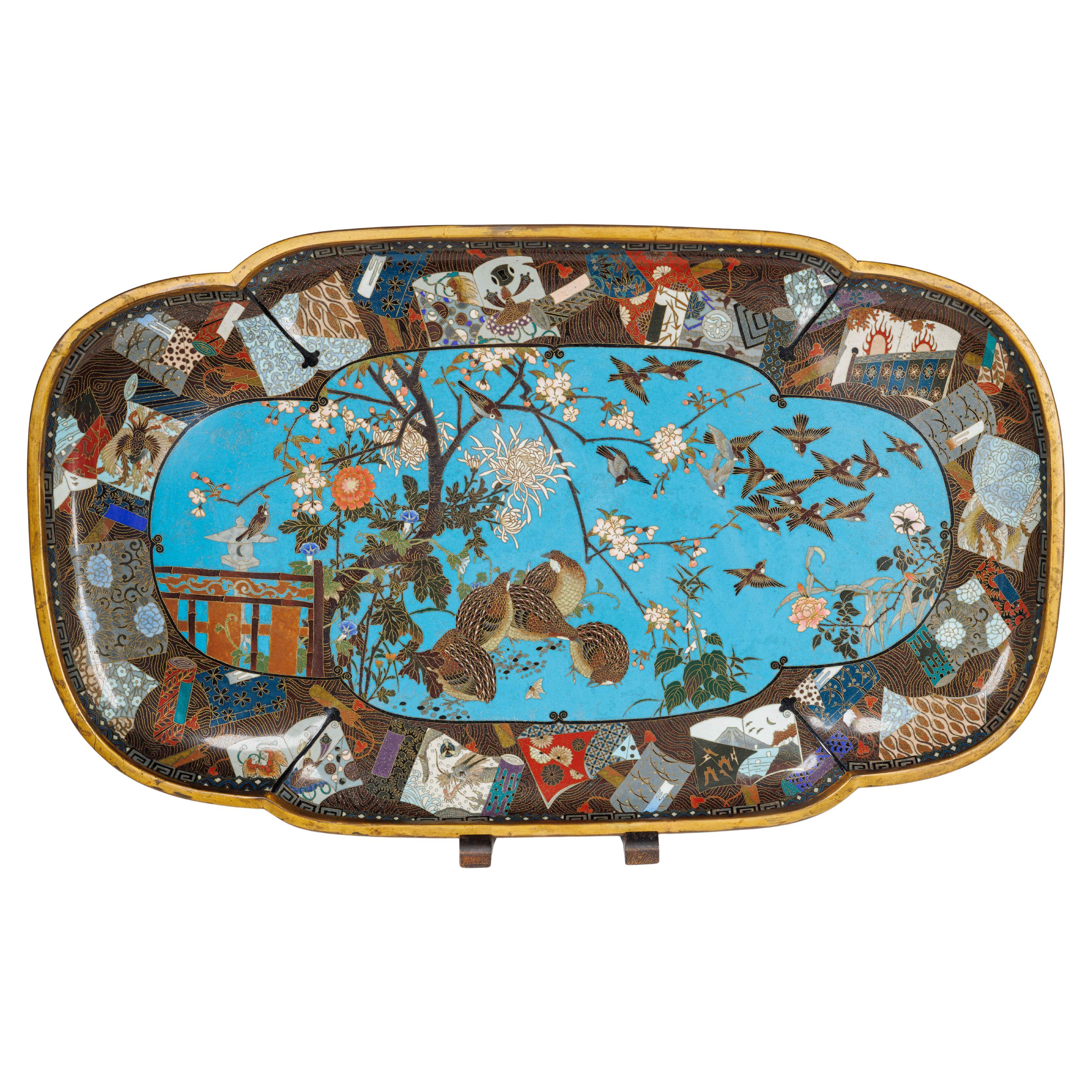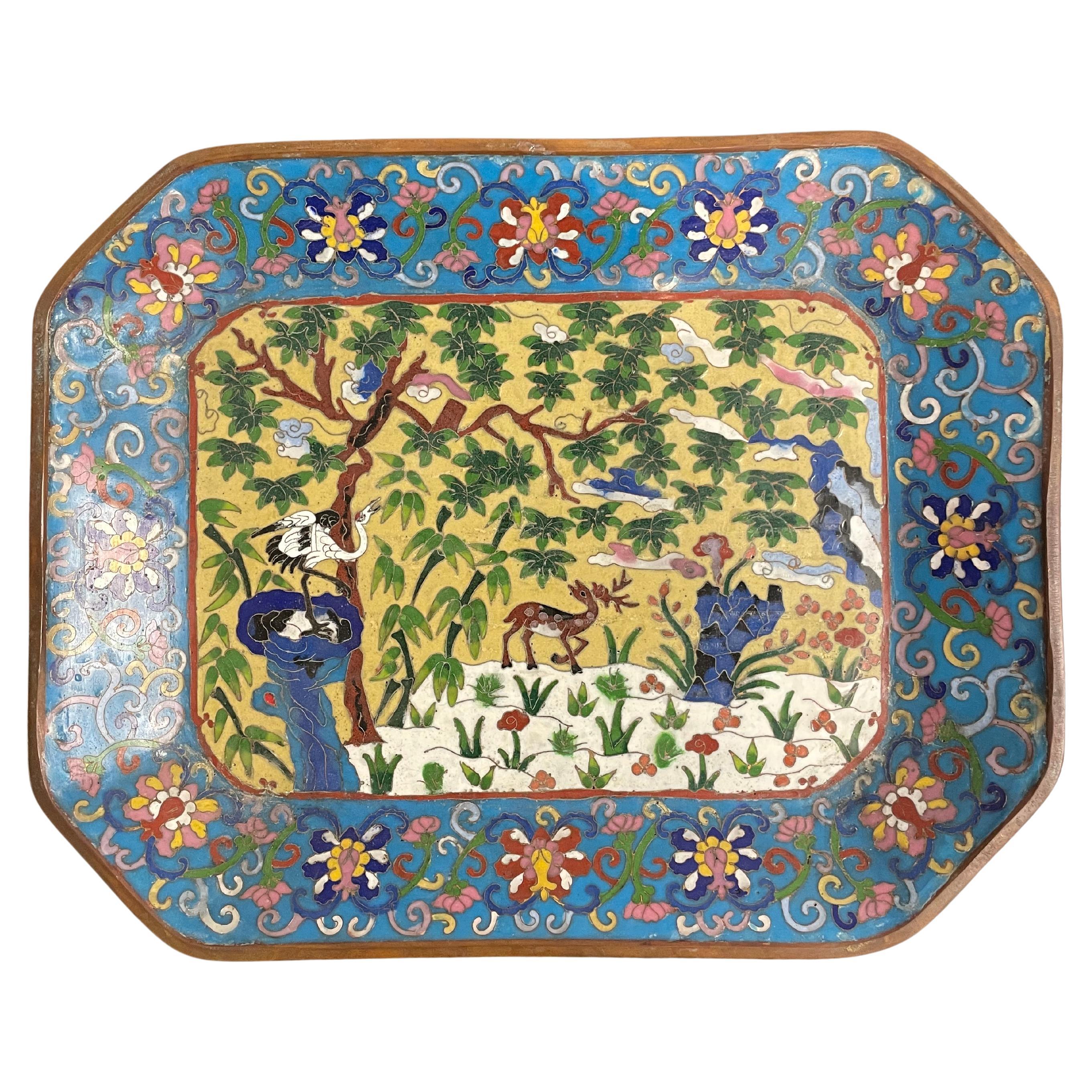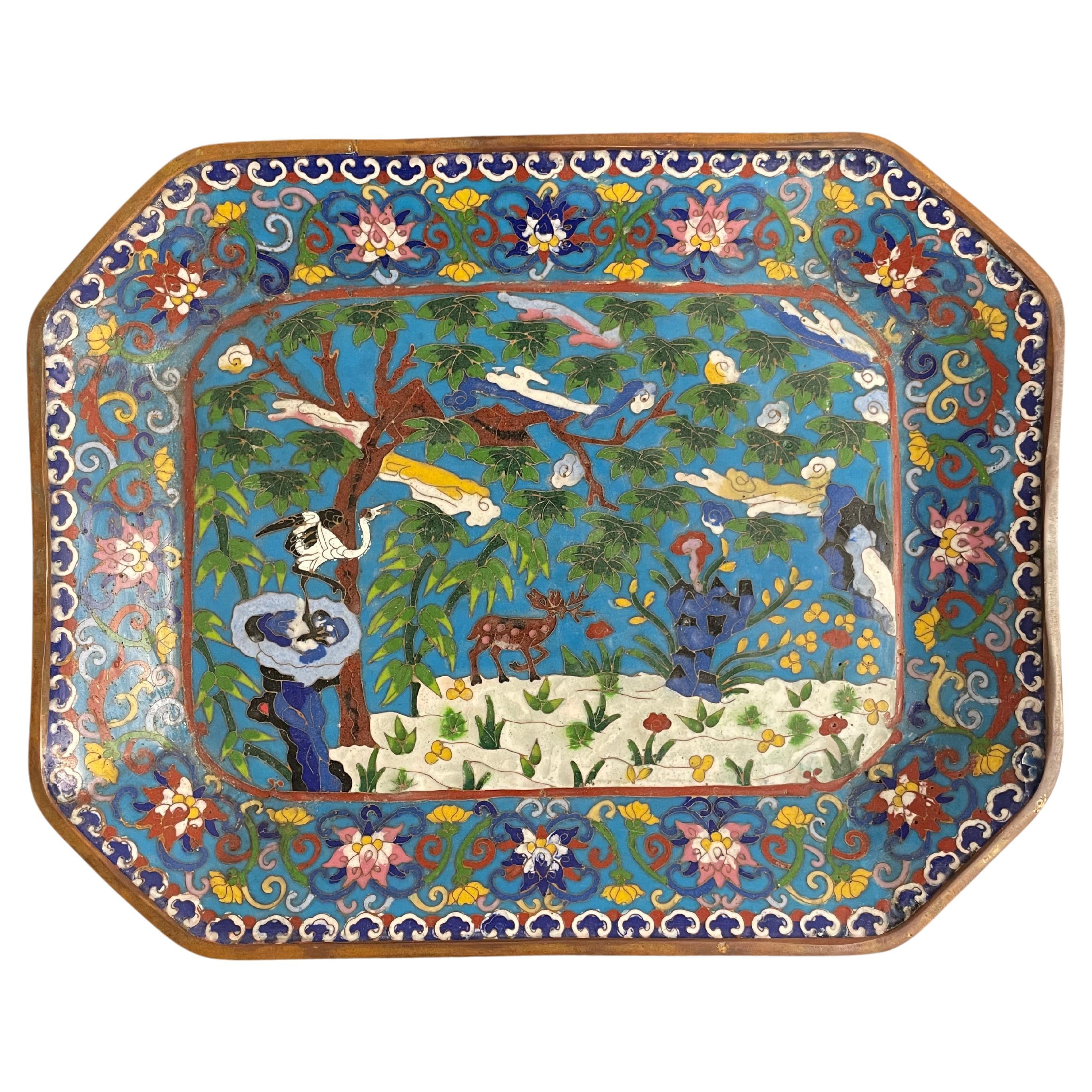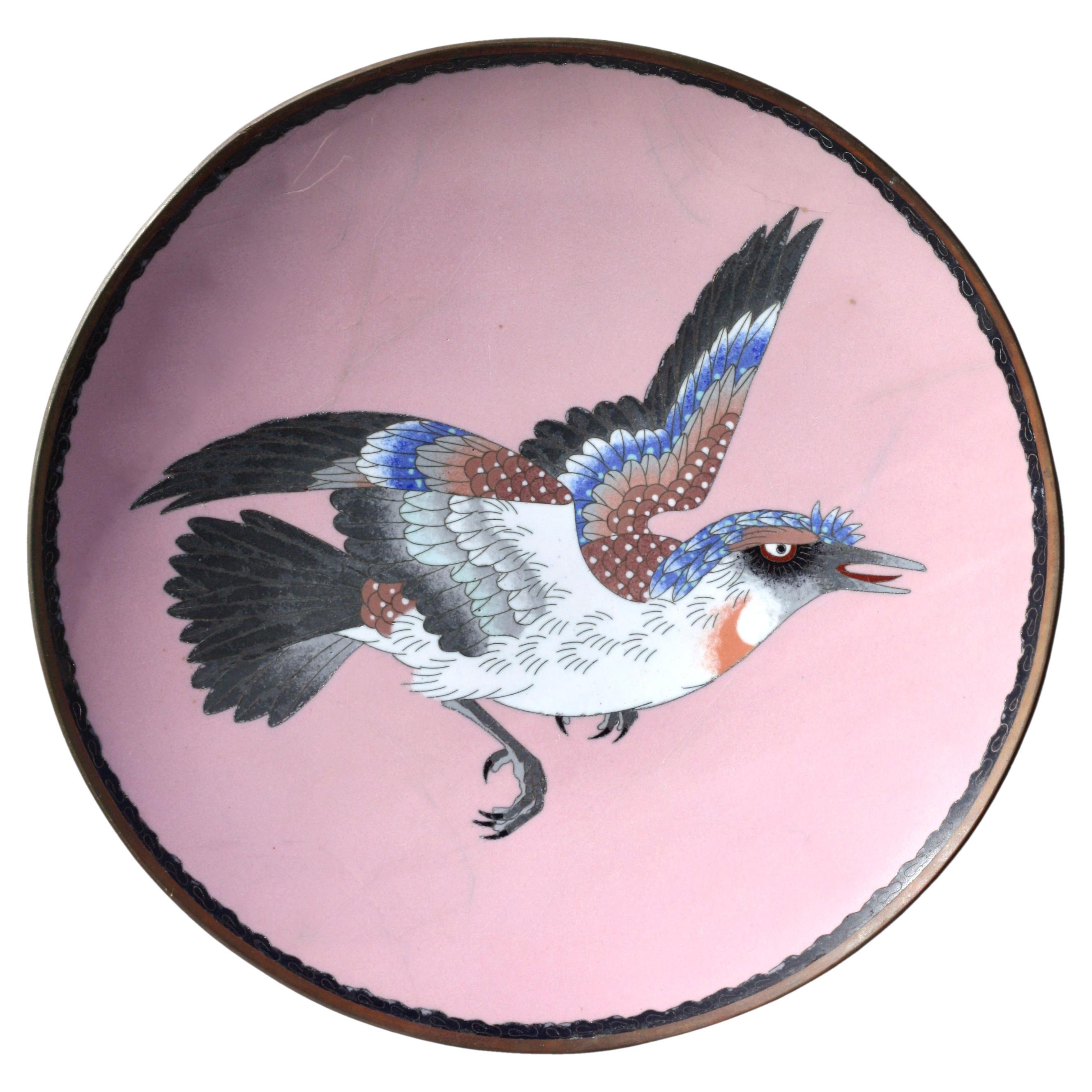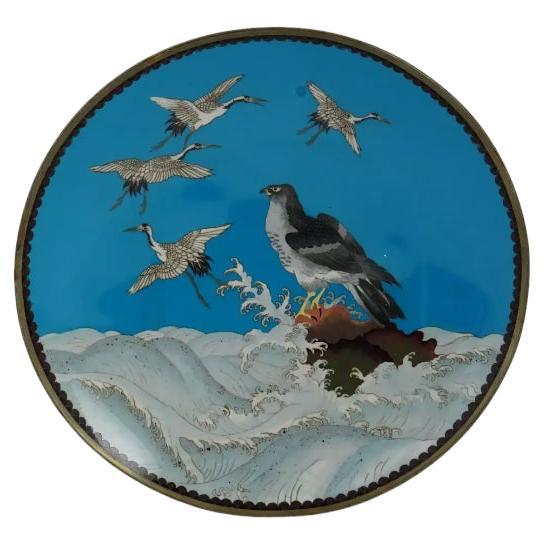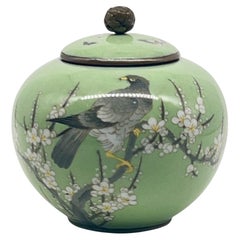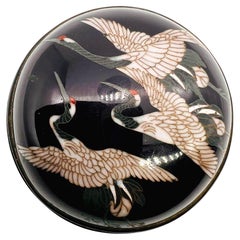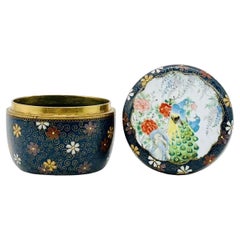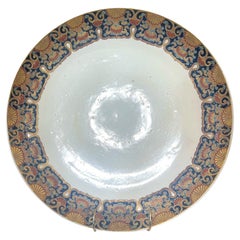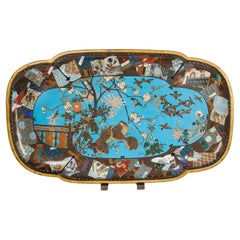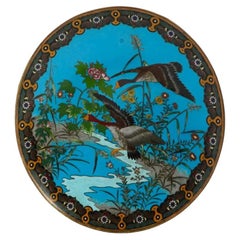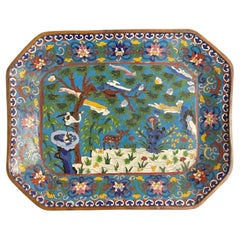Items Similar to A Fine Japanese Meiji Period Cloisonné Enamel Tray Attributed to Namikawa Sösuke
Want more images or videos?
Request additional images or videos from the seller
1 of 17
A Fine Japanese Meiji Period Cloisonné Enamel Tray Attributed to Namikawa Sösuke
$2,419.60
£1,750
€2,063.60
CA$3,349.56
A$3,631.90
CHF 1,927.41
MX$44,731.51
NOK 23,889.01
SEK 22,545.73
DKK 15,403.19
About the Item
A Japanese Meiji Period Cloisonné Enamel
Tray Attributed to Namikawa Sösuke, Late 19th Century
A refined rectangular cloisonné enamel tray with softly rounded corners and shallow raised sides.
The central panel features a tranquil scene of two doves resting beneath a flowering branch and beside a stylized tree, rendered in delicate wirework and naturalistic enamel tones. The image is set against a subtly shaded ground transitioning from pale blue to celadon, enhancing the sense of depth and tranquility in the scene.
The naturalistic modeling of the birds and foliage, along with the serene asymmetrical composition, reflects the painterly aesthetic associated with Namikawa Sösuke's Tokyo workshop.
The interior is bordered by a band of scrolling floral motifs .The reverse is richly decorated with a large central peony medallion surrounded by swirling red tendrils and foliage on a blue enamel field. The exterior sides continue the decorative theme with a scale-pattern border in alternating green and mauve tones.
Size: length 31.5cm.
Condition: Generally good condition with no damage or repairs. Typical light surface scratches and wear, slightly more pronounced to the base.
Though unsigned, the painterly quality, compositional refinement, and tonal sophistication suggest the influence of Namikawa Sösuke, one of the foremost cloisonne artists of the Meiji era, known for merging fine art sensibility with enamel craftsmanship.
- Dimensions:Height: 12.21 in (31 cm)Width: 12.21 in (31 cm)Depth: 8.27 in (21 cm)
- Materials and Techniques:Enamel,Cloissoné
- Place of Origin:
- Period:
- Date of Manufacture:1890
- Condition:Wear consistent with age and use.
- Seller Location:London, GB
- Reference Number:1stDibs: LU8001244906182
About the Seller
No Reviews Yet
Vetted Professional Seller
Every seller passes strict standards for authenticity and reliability
Established in 2001
1stDibs seller since 2023
16 sales on 1stDibs
- ShippingRetrieving quote...Shipping from: London, United Kingdom
- Return Policy
Authenticity Guarantee
In the unlikely event there’s an issue with an item’s authenticity, contact us within 1 year for a full refund. DetailsMoney-Back Guarantee
If your item is not as described, is damaged in transit, or does not arrive, contact us within 7 days for a full refund. Details24-Hour Cancellation
You have a 24-hour grace period in which to reconsider your purchase, with no questions asked.Vetted Professional Sellers
Our world-class sellers must adhere to strict standards for service and quality, maintaining the integrity of our listings.Price-Match Guarantee
If you find that a seller listed the same item for a lower price elsewhere, we’ll match it.Trusted Global Delivery
Our best-in-class carrier network provides specialized shipping options worldwide, including custom delivery.More From This Seller
View AllA Fine Japanese Cloisonne Enamel Koro. Meiji period
Located in London, GB
Japanese Silver Wire Cloisonné Koro with a Bird , butterflies and Floral Design
Meiji Period (1868-1912)
A beautifully executed Meiji-period Japanese cloisonné koro, featuring a...
Category
Antique 19th Century Japanese Metalwork
Materials
Enamel
A Fine Japanese Cloisonné-enamel kogo box. Meiji period
Located in London, GB
A Fine Japanese Cloisonne Enamel Kogo Box.
Meiji period.
Worked in silver wire and decorated with cranes in flight on a dark blue background.
Interior in black enamel.
In go...
Category
Antique 19th Century Japanese Metalwork
Materials
Enamel
A Fine Unusual Antique Japanese Cloisonne Enamel Kogo Box and Cover By Inaba
Located in London, GB
A Fine Unusual Antique Japanese Cloisonne Enamel Kogo Box and Cover signed by Inaba
Meiji Period.
Worked in gold wire and decorated all over with swirls and flowers on dark blue...
Category
Antique 19th Century Japanese Metalwork
Materials
Enamel
An Large Imperial Japanese Satsuma Charger By Masanobu, Meiji era
Located in London, GB
An Imperial Japanese Satsuma Charger
By Masanobu, Meiji era
Of large circular form, the wide rim lavishly decorated in raised polychrome enamels and gilt with a continuous border of...
Category
Antique 19th Century Japanese Ceramics
Materials
Ceramic
Magnificent Antique Japanese Satsuma Floral Plate, Signed
Located in London, GB
A Magnificent Satsuma Plate.
Late Meiji period, early 20th C. Signed.
Very elegant Japanese satsuma plate hand painted with a magnificent floral decorations. The painting is a t...
Category
Antique Late 19th Century Japanese Ceramics
Materials
Ceramic, Porcelain
A Fine Japanese Satsuma kogo (incense box) Signed by Kinkozan. Meiji period
Located in London, GB
A Satsuma circular kogo (incense box) and cover signed by Kinkozan
19th century
Finely painted in enamels and gilt, the cover with wisteria and a scene of a woman and children ...
Category
Antique Late 19th Century Japanese Ceramics
Materials
Ceramic, Porcelain
You May Also Like
A Grand Meiji Cloisonné Enamel Tray Featuring Cherry Blossoms and Birds
Located in Queens, NY
A Grand Meiji Japanese Cloisonné Enamel Tray – Lush Cherry Blossom Garden with Sparrows, Quail, and Japanese Fountain, Circa 1890
This monumental exhibition-size Meiji period Japane...
Category
Antique 19th Century Japanese Meiji Metalwork
Materials
Enamel
Antique Japanese Meiji Era Cloisonne Enamel Plate Goto
Located in Long Island City, NY
An antique Japanese, probably Goto school, enamel over copper charger plate.
The exterior of the plate is adorned with a polychrome image of ducks flying over a pond with blossomin...
Category
Antique Late 19th Century Japanese Metalwork
Materials
Copper, Enamel
A Chinese Cloisonne Tray with Qianlong Mark, Early 20th Century
Located in ARMADALE, VIC
A Chinese Cloisonne Tray with Qianlong Mark, Early 20th Century
Home decor, Interior design and collectibles.
Provenance: Private Victoria Collection.
...
Category
Early 20th Century Chinese Metalwork
Materials
Bronze
$460 Sale Price
50% Off
A Chinese Cloisonne Tray with Qianlong Mark, Early 20th Century
Located in ARMADALE, VIC
A Chinese Cloisonne Tray with Qianlong Mark, Early 20th Century
Home decor, Interior design and collectibles.
Provenance: Private Victoria Collection.
...
Category
Early 20th Century Chinese Metalwork
Materials
Bronze
A Cloisonné Dish Meiji period (1868-1912)
Located in West Palm Beach, FL
A Cloisonne Dish
Meiji period (1868-1912)
decorated with a lively Falcon reserved on a light pink ground
diameter 11 3/4 inches
Category
20th Century Ceramics
Materials
Ceramic
Antique Japanese Meiji Era Cloisonne Enamel Plate
Located in Long Island City, NY
An antique Japanese Meiji era enamel over copper charger plate. The exterior of the plate is adorned with a polychrome scene with an eagle standing on a rock and cranes flying over w...
Category
Antique Late 19th Century Japanese Meiji Metalwork
Materials
Copper, Enamel
More Ways To Browse
Antique Round Tray
Meiji Japan Tray
Cloisonne Tray
Namikawa Sosuke
Brass Arabic Coffee Pot
Chinese Hand Warmer
Cloisonne Tray
Copper Dallah
Copper Incense Burner
Japanese Kettle
Large Japanese Bronze Incense Burner
Namikawa Sosuke
Bronze Chinese Stand
Chinese Cloisonne Plate
Hammered Brass Plate India
Incense Burner Dragon
Islamic Coffee Pot
Japanese Bronze Lotus
